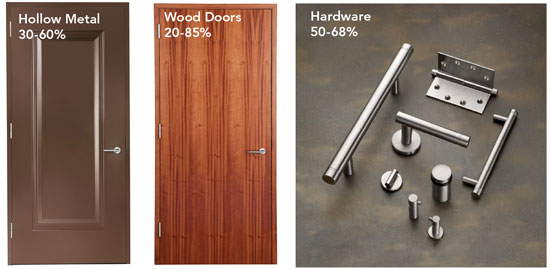Door Opening Solutions in LEED for Healthcare
Material and Resources (MR) Related to Door Openings
LEED for Healthcare addresses a range of material and resource items, many of which are common to other LEED rating systems and some which are not. In a healthcare facility with many door openings, appropriate design and selection of those products can contribute notably to the total of 16 possible points in this category.
Building Reuse Strategies
MR Credit 1.2 Building Reuse – Maintain Existing Interior Non-Structural Elements (1 point). Doors are included in non-structural elements that can be re-used in existing buildings. The goal is to reuse elements of buildings that are salvageable where possible. Since doors and hardware generally have a long service life, their re-use on LEED projects, should be simple, especially when they are of good quality to begin with. It is possible to utilize manufacturer facility surveys to determine materials that can be reused. Doors in particular are smooth flat surfaces that can be re-used as a desk, storage platform, etc. or can be donated to a cause like Habitat ReStores.
Sustainably Sourced Product Strategies
MR Credit 3 Sustainably Sourced Materials & Products (1 – 4 points). The intent behind this credit is to reduce the environmental burdens of materials and products acquired to construct buildings and to upgrade building services. One point and up to a maximum of four will be awarded for each 10 percent of the total value of all building materials and products used in the project (based on cost) that meet any of the criteria below.
- Salvaged, refurbished or reused materials: As mentioned above, doors, frames, hardware, and related items are commonly able to be salvaged, re-furbished, or re-used.
- Recycled content: In the door and hardware industry recycled content ranges from 20 percent to 95 percent, depending on the product so it can be very valuable to run calculations. Most recycled content percentages are now available by manufacturer and product line.
- Regionally sourced/manufactured materials and products that have been extracted, harvested or recovered, as well as manufactured within 500 miles of the project site: This will obviously be location dependent and may be difficult to achieve in some cases.
- Building materials or products shipped by rail or water have been extracted, harvested or recovered, as well as manufactured within a 500 mile total travel distance of the project site using a weighted average: The formula for showing compliance with this point recognizes the possibility of using sustainable sources of transportation such as rail and water transportation making many door opening products eligible.
- Rapidly renewable materials: Interior doors can be specified and manufactured with agrifiber wheat based cores or from bamboo veneer surfaces that are each made from material that has a 10 year or shorter harvest cycle. In some cases, these doors can be specified to achieve a 45 minute fire rating.
- Wood certified, in accordance with the Forest Stewardship Council's (FSC) Principles and Criteria: Wood doors are available that meet all of the FSC criteria including the required Chain of Custody numbers.
- LEED for Healthcare further requires that all wall, ceiling and flooring systems and finishes, composite wood, agrifiber and fiberglass products, both exterior and interior adhesives, sealants, coatings, roofing, and waterproofing products must meet the relevant IEQ Credit 4: Low-Emitting Materials requirements to contribute toward this credit. That means, among other things, that wood doors containing composite wood and agrifiber must contain no added urea formaldehyde to contribute credit in this section.
- Door openings may be considered part of the wall systems requirements of this section and must meet the requirements of CA01350 testing, as shown by GREENGUARD Indoor Air Quality Testing to contribute credit in this section.
 |
Different door materials can contain different levels of recycled content but represent a significant dollar value in many building projects. Photos courtesy of ASSA ABLOY |
Clearly, then, it is worthwhile to consider the components of door openings as a potential significant contributor to responsible Materials and Resources specifications and design, as well as insure that they meet the required Low Emitting Materials credits.









